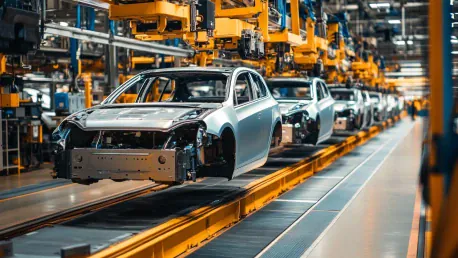The automotive industry is undergoing a significant transformation, driven by advancements in artificial intelligence (AI) and cloud computing. Amazon Web Services (AWS) is at the forefront of this revolution, partnering with leading car manufacturers to develop smarter, more efficient vehicles. This article explores how AWS is leveraging its technological prowess to reshape the automotive landscape.
The Rise of Software-Defined Vehicles (SDVs)
Continuous Updates and Improvements
Software-defined vehicles (SDVs) represent a paradigm shift in the automotive industry. Unlike traditional vehicles, SDVs can receive continuous updates and improvements via over-the-air connectivity. This capability allows manufacturers to enhance vehicle performance, safety, and user experience without requiring physical modifications. AWS’s cloud infrastructure plays a crucial role in enabling these updates, providing a scalable and reliable platform for data processing and software deployment. For instance, over-the-air updates can introduce new safety features, optimize engine performance, and improve infotainment systems without needing a visit to the dealership.
Furthermore, with the ability to continuously update software, manufacturers can quickly address and fix potential issues, which enhances vehicle longevity and reduces the likelihood of large-scale recalls. The process of deploying these updates seamlessly over the cloud ensures minimal disruption for the vehicle owner while dramatically extending the functional lifespan of the vehicle. This dynamic approach to automotive updates marks a significant departure from the traditional reliance on physical hardware changes and periodic dealership visits for maintenance and upgrades.
Enhancing Vehicle Performance and Safety
AI and cloud computing are integral to the development of SDVs. AWS’s advanced machine learning tools enable car manufacturers to analyze vast amounts of data in real-time, leading to improved vehicle performance and safety. For instance, AI-driven systems can predict maintenance needs, optimize fuel efficiency, and enhance driver assistance features. By leveraging AWS’s cloud services, automakers can create more responsive and adaptive vehicles that meet the evolving needs of consumers.
In addition, real-time data analysis provided by AWS allows for on-the-fly adjustments and personalized interactions between the vehicle and the driver. For example, predictive maintenance powered by AI can lead to significant cost savings and increased safety by identifying potential mechanical failures before they occur. Moreover, enhanced driver assistance features such as adaptive cruise control, lane-keeping assistance, and automatic emergency braking can be constantly refined and improved through continuous data streams processed by cloud computing, all contributing to a safer driving experience.
Strategic Partnerships with Automotive Giants
Collaboration with Honda Motor Co. Ltd.
One of the most notable partnerships is between AWS and Honda Motor Co. Ltd. Honda has developed a Digital Proving Ground (DPG) using AWS’s cloud simulation platform. This virtual environment allows Honda to design and test vehicles digitally, significantly reducing the reliance on physical prototypes. The DPG enables the collection and analysis of vital data on electric vehicles’ range, energy consumption, and performance, providing a more controlled and comprehensive testing environment than physical prototypes. By leveraging these insights, Honda can accelerate the development cycle of new vehicles, reducing both time and financial costs associated with traditional testing methods.
Moreover, the DPG allows for extensive testing in different simulated environments and scenarios that would be challenging to replicate in the real world. By utilizing AWS’s machine learning and data analytics tools, Honda can detect and rectify issues early in the design phase, ensuring a more reliable final product. This collaboration exemplifies how virtual simulations and cloud-based data processing are transforming vehicle development, making it more efficient and cost-effective.
HERE Technologies and Advanced Navigation
AWS’s collaboration with HERE Technologies focuses on enhancing location-based services for SDVs. HERE’s high-definition live maps, combined with AWS’s cloud tools, facilitate real-time navigation and improved battery usage for electric vehicles (EVs). These advanced mapping capabilities ensure precise navigation services, crucial for the development of connected and autonomous vehicles. Additionally, HERE’s SceneXtract tool simplifies virtual testing by creating detailed virtual simulations. This partnership underscores the importance of accurate mapping and real-time data in developing advanced driver assistance systems and automated driving technologies.
Furthermore, the integration of HERE’s mapping technology with AWS’s cloud infrastructure allows for continuous updates and real-time data processing, which significantly enhances the functionality and accuracy of navigation systems. This collaboration enables automakers to provide drivers with up-to-date routes, traffic conditions, and efficient battery management, improving overall driving experiences.
Valeo’s Virtualized Testing Platforms
Valeo has introduced innovative solutions like the Virtualized Hardware Lab and Cloud Hardware Lab in collaboration with AWS. These platforms allow carmakers to test software on virtual components, speeding up the development process and reducing costs. The Virtualized Hardware Lab accelerates software testing by up to 40%, while the Cloud Hardware Lab provides remote access to large-scale testing systems. These advancements highlight the significance of virtual environments in modern vehicle development, providing a cost-effective alternative to traditional physical testing.
Additionally, by using these virtual environments, manufacturers can conduct extensive and varied testing scenarios without the need for expensive prototypes. This flexibility allows for rapid iterations and improvements, ensuring higher software reliability and performance before physical deployment. Through AWS’s scalable cloud services, Valeo can offer these advanced testing solutions to multiple automotive clients simultaneously, streamlining the entire development process across the industry.
Leveraging AI for Enhanced Driver Assistance
Generative AI Services
AWS’s generative AI services, such as Amazon Bedrock, are revolutionizing driver assistance technologies. Honda, for example, is using these services to develop systems that guide drivers to optimal charging stations based on factors like battery level and proximity to amenities. This innovation showcases the growing integration of AI in enhancing user experiences and operational efficiencies in EVs. By providing personalized recommendations, AI-driven systems can significantly improve the convenience and satisfaction of drivers.
In addition, these AI-powered services are capable of learning and adapting to individual driver habits and preferences, ensuring a tailored experience that evolves over time. Through continuous data collection and analysis, these systems can provide real-time advice and suggestions, optimizing travel routes and ensuring efficient vehicle operation. The seamless integration of these generative AI services into the vehicle’s ecosystem highlights the commitment of automakers like Honda to advance their offerings using cutting-edge technology provided by AWS.
Real-Time Data Processing
Real-time data processing is crucial for the effective implementation of AI in the automotive industry. AWS’s cloud infrastructure enables the rapid analysis of data from various sensors and cameras installed in vehicles. This capability allows for immediate responses to changing road conditions, enhancing the safety and performance of driver assistance systems. By processing data in real-time, AWS helps automakers create more reliable and adaptive vehicles that can respond to dynamic driving environments.
Moreover, real-time data processing enables features such as adaptive cruise control, collision detection, and emergency braking to function more effectively, drastically reducing the chances of accidents and enhancing overall road safety. The ability to process vast amounts of data instantaneously ensures that driver assistance systems can make quick, informed decisions, providing a smoother and safer driving experience.
The Future of Autonomous Driving
Incremental Innovations
While the industry has yet to achieve fully autonomous vehicles, incremental innovations driven by AI and cloud computing are paving the way for future advancements. AWS’s cloud services support the development of autonomous driving technologies by providing the necessary computational power and data storage. These innovations contribute to making driving safer, more efficient, and better informed by real-time data and AI-driven insights. Each step forward brings us closer to realizing the full potential of autonomous driving, built on a foundation of continuous improvements and refinements.
As we move toward a future where fully autonomous vehicles become a reality, these incremental innovations are crucial in establishing a robust and reliable foundation. By gradually introducing and perfecting elements of autonomous technology, automakers can ensure the safety and reliability of these systems, gaining valuable data and experience along the way. This step-by-step approach allows for careful monitoring and improvement, ultimately leading to a smoother transition to fully autonomous driving.
Ecosystem Approach
The convergence of the automotive and technology sectors is accelerating, with software gradually becoming the core component of vehicle manufacturing. AWS’s ecosystem approach, which integrates various cloud and AI services, enables automakers to develop comprehensive solutions for autonomous driving. This approach fosters collaboration between different stakeholders, including car manufacturers, technology providers, and regulatory bodies, to create a cohesive and efficient development environment. The unified ecosystem ensures that all components work seamlessly together, driving innovation and efficiency throughout the industry.
By leveraging AWS’s extensive suite of tools and services, automakers can access a comprehensive and scalable development platform. This ecosystem approach enables the efficient sharing of data, insights, and best practices, facilitating more rapid advancements in autonomous driving technology. The collaborative environment supported by AWS ensures that all parties can work together to overcome challenges and push the boundaries of what is possible in the realm of vehicle automation.
Conclusion
The automotive industry is currently experiencing a major transformation, largely due to the significant advancements in artificial intelligence (AI) and cloud computing. At the forefront of this revolution is Amazon Web Services (AWS), which is working in collaboration with leading automobile manufacturers to produce smarter and more efficient vehicles. AWS leverages its technological expertise to bring about a seismic shift in the automotive landscape.
This article delves into the various ways AWS is utilizing its advanced technological capabilities to fundamentally reshape the industry. The integration of AI and cloud computing enables the creation of next-generation vehicles that not only improve driving experiences but also enhance safety and efficiency. Through these collaborations, AWS is helping to drive innovation and set new standards for the future of transportation. As the industry evolves, AWS continues to push the boundaries of what is possible, making it a pivotal player in the ongoing transformation of automotive technology.









